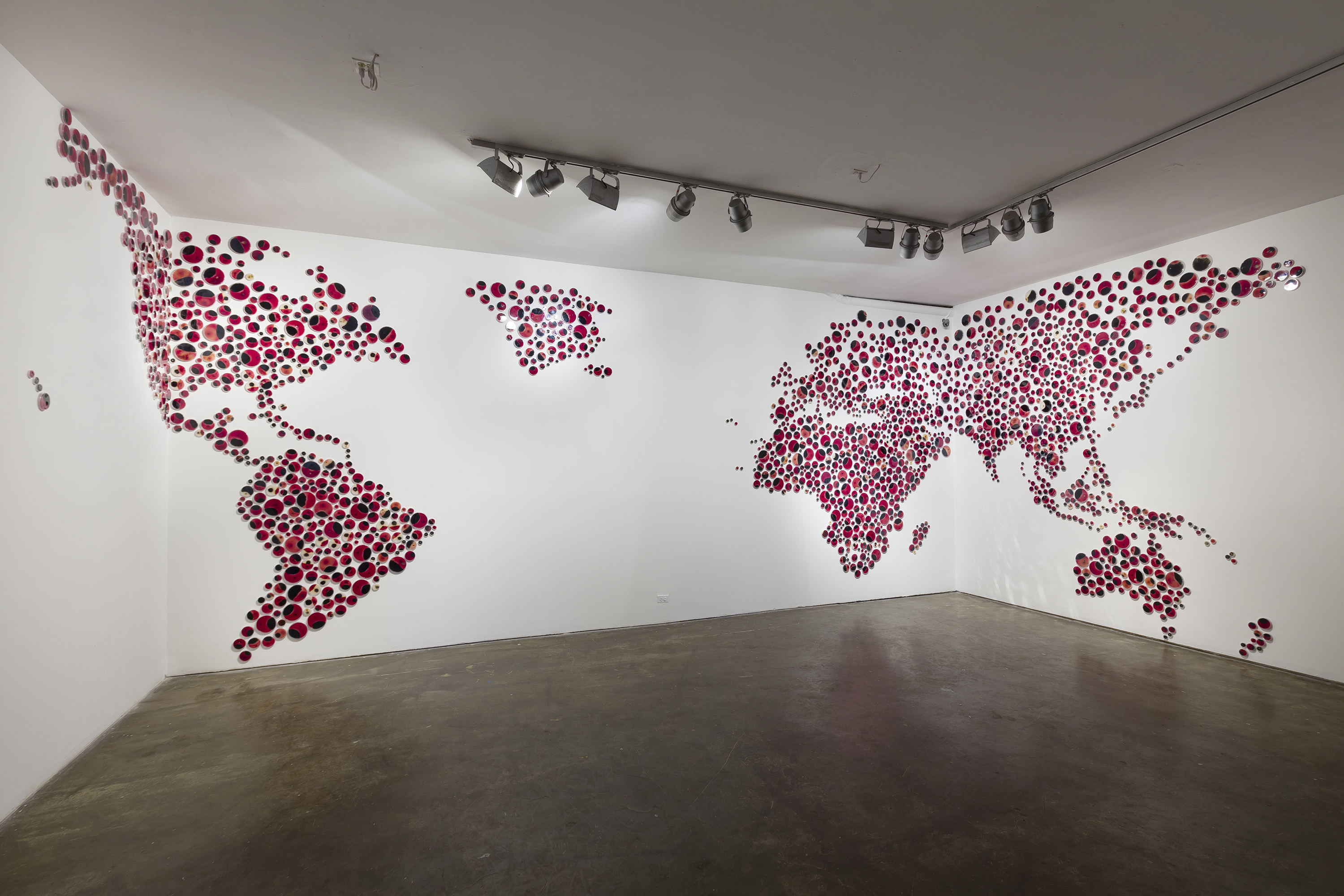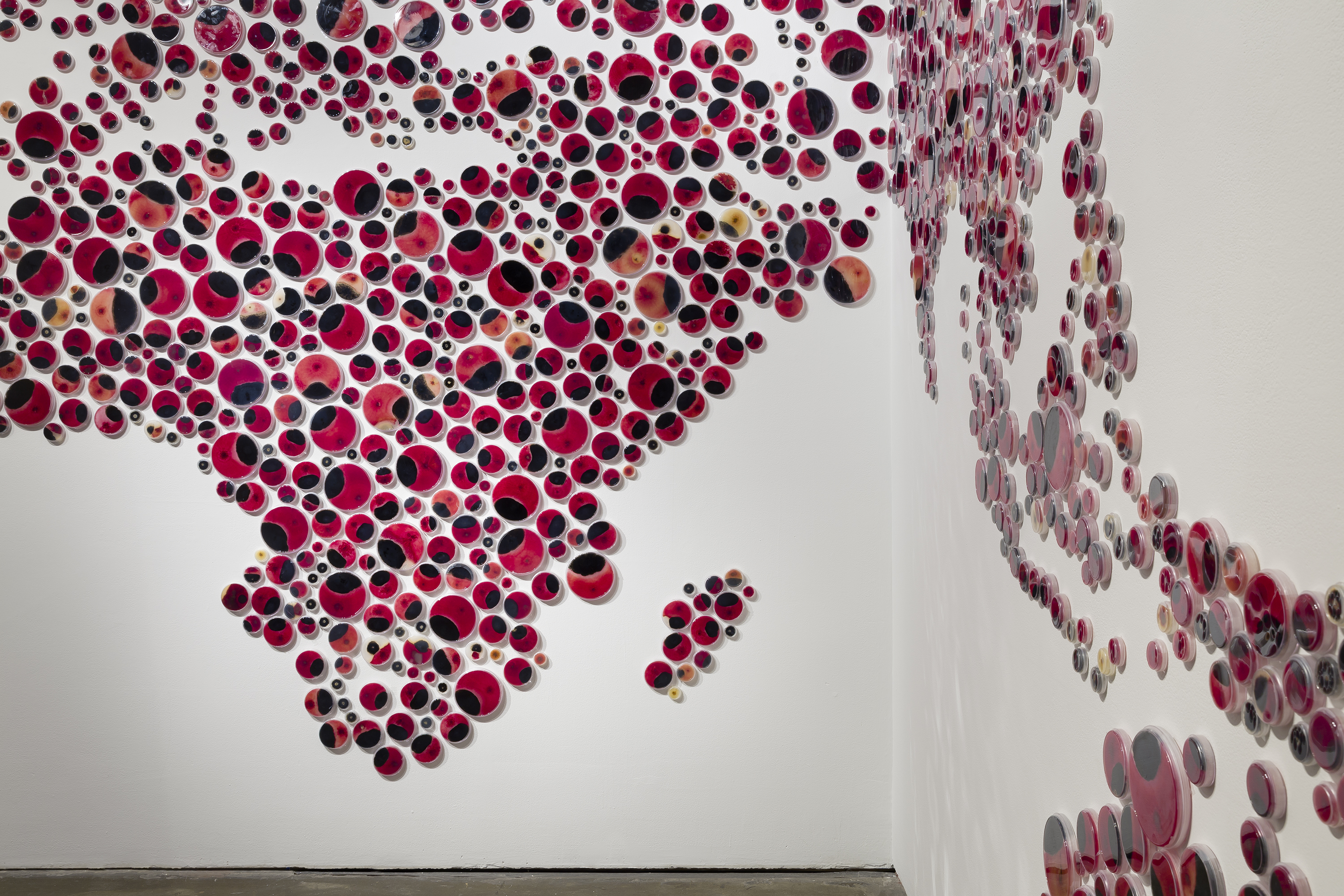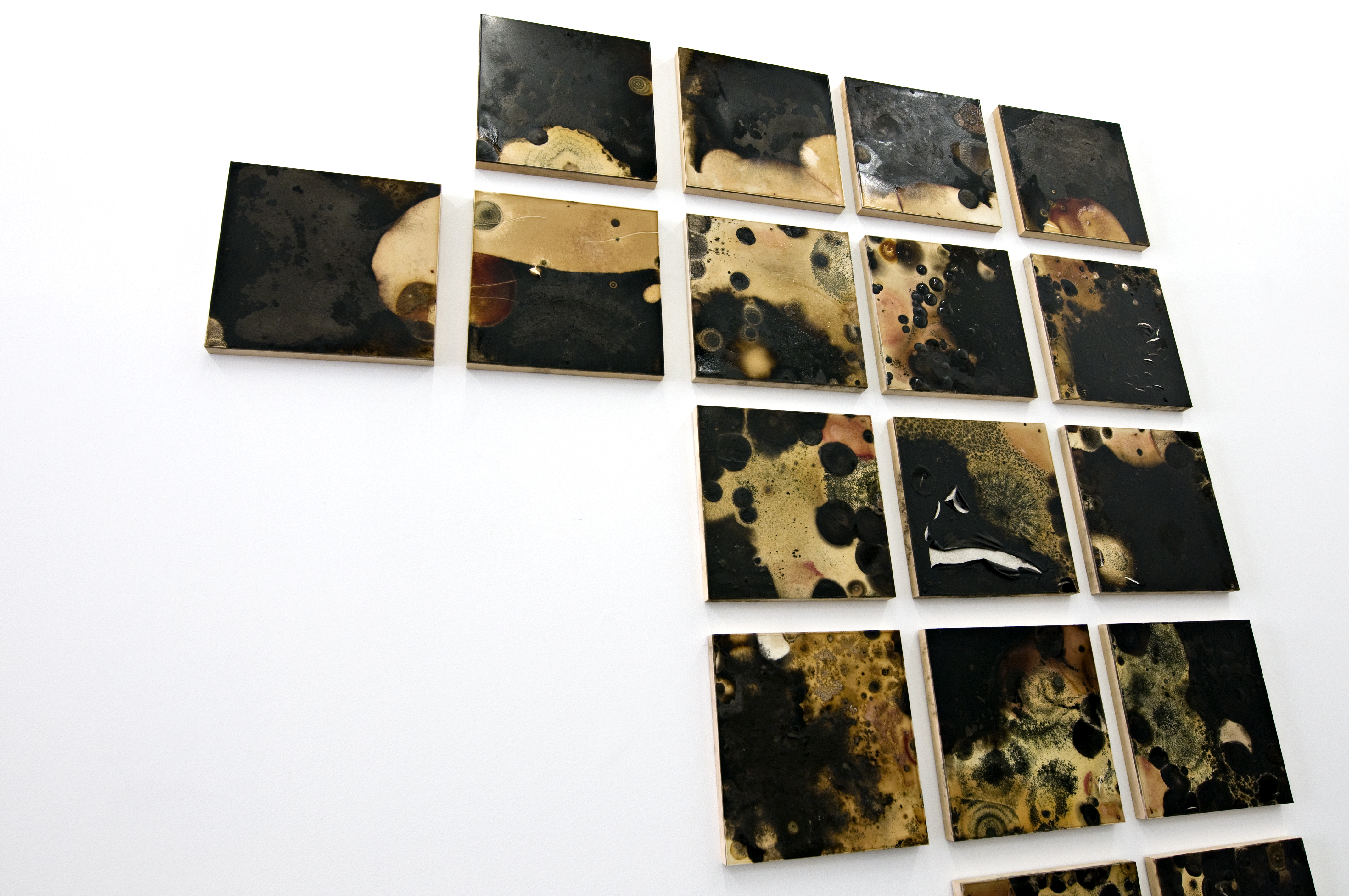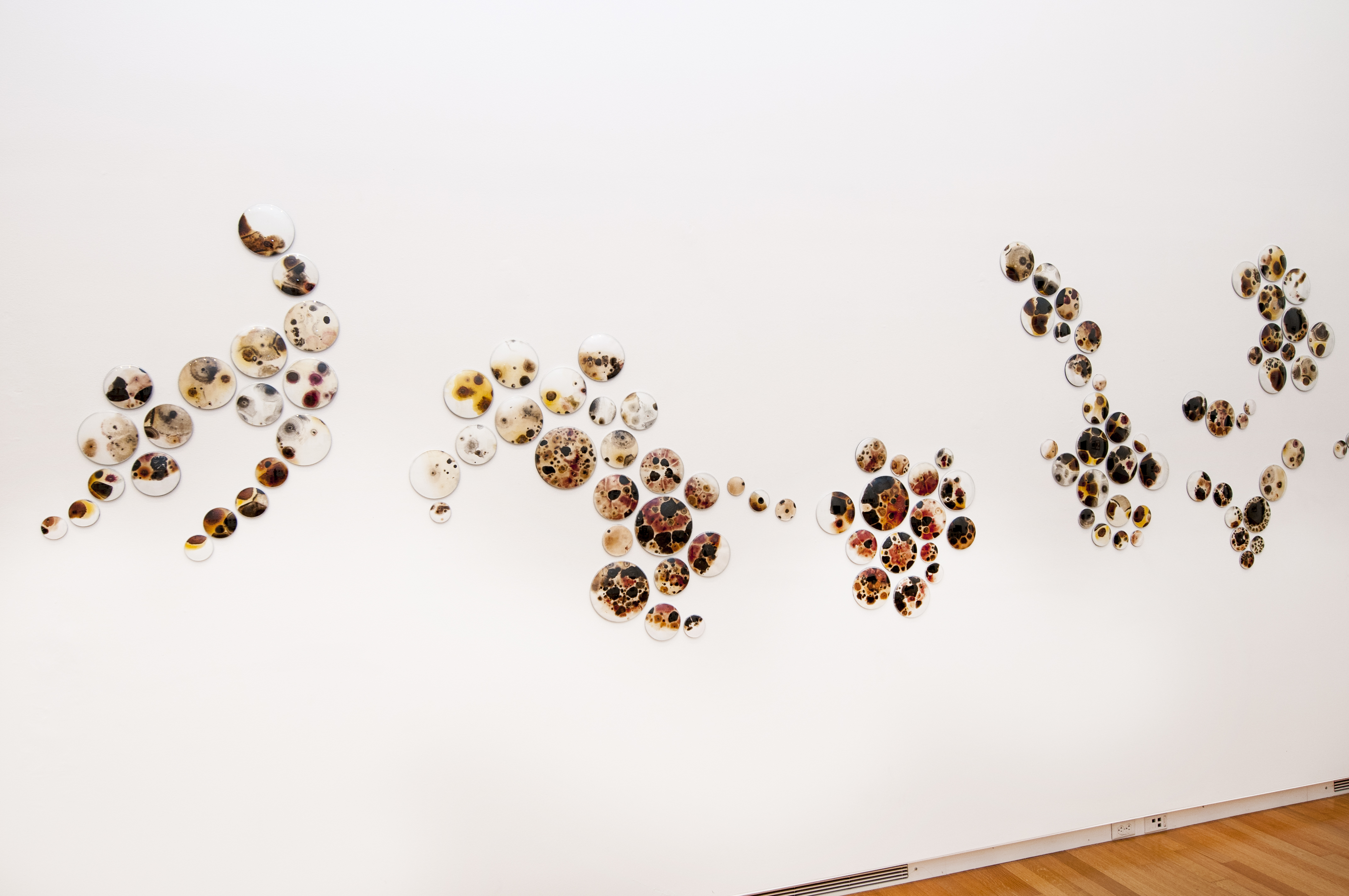About Selin
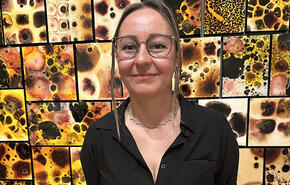
Selin Balci is an interdisciplinary artist and researcher who merges art and science through innovative use of biological materials, scientific tools, and traditional art supplies. Her work is categorized as bio-art, a contemporary artistic approach that incorporates living organisms into creative expression. With a background in both science and art, Selin adeptly explores the dynamic relationship between the natural world and human intervention within this emerging field. Selin holds a… more
Bordered World
Bordered World creates a competition for resources, territorial wars, and struggle for power and control among living organisms. In this project, I reference the fundamental, underlying social dilemmas and principles of our existence in an effort to understand and highlight social issues. My concepts are explored using living entities such as fungus and mold to recreate observable interactions and conflicts across the picture surface, where the outcomes reveal boundaries, edges and distinctive forms. In Bordered World, all vital resources are restricted. This limited environment makes microbes compete for resources, dominate a particular area or become invasive and endanger others. When they share the same living platform, a conflict for resources arise and eventually this results with a borderline. The behaviors of the microorganisms resemble human actions and motives. Visually representing the world map, these microbes act as metaphors for war and the human predicament.
"In Selin Balci’s bio-art installation Bordered World, 2,500 Petri dishes compose a three-dimensional kaleidoscopic world map representing the universal struggle for survival and dominance. Within each hand “painted” Petri dish, live molds and fungi are in an observable battle for limited resources. Distinctive borders slowly form and new colonies develop during this microscopic feud."
Smack Mellon Curator
-
 Bordered WorldEvolving mold in 2500 Petri dishes at Smack Mellon, Brooklyn, NY, 2014-15
Bordered WorldEvolving mold in 2500 Petri dishes at Smack Mellon, Brooklyn, NY, 2014-15 -
 Bordered WorldEvolving mold in 2500 Petri dishes at Smack Mellon, Brooklyn, NY, 2014-15
Bordered WorldEvolving mold in 2500 Petri dishes at Smack Mellon, Brooklyn, NY, 2014-15 -
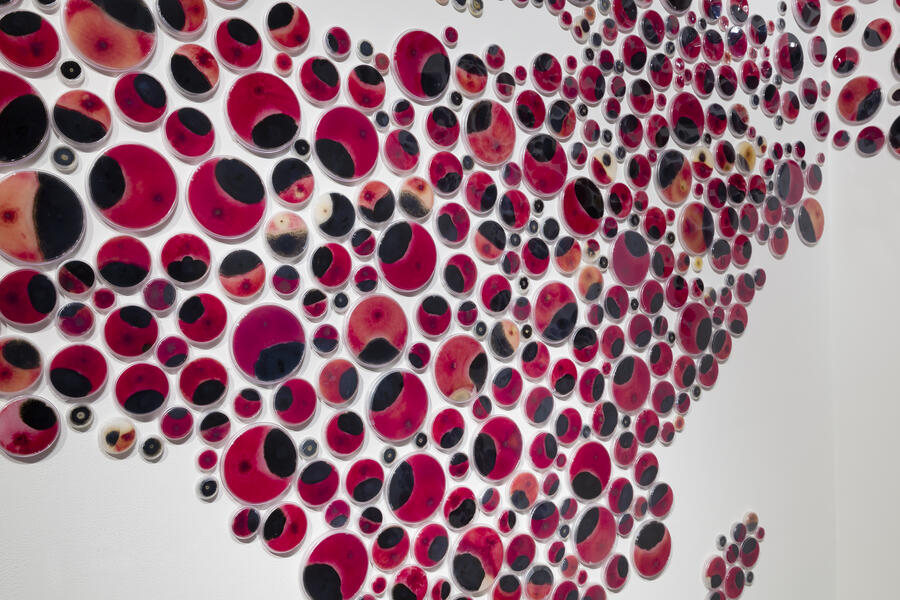 Bordered WorldEvolving mold in 2500 Petri dishes at Smack Mellon, Brooklyn, NY, 2014-15
Bordered WorldEvolving mold in 2500 Petri dishes at Smack Mellon, Brooklyn, NY, 2014-15 -
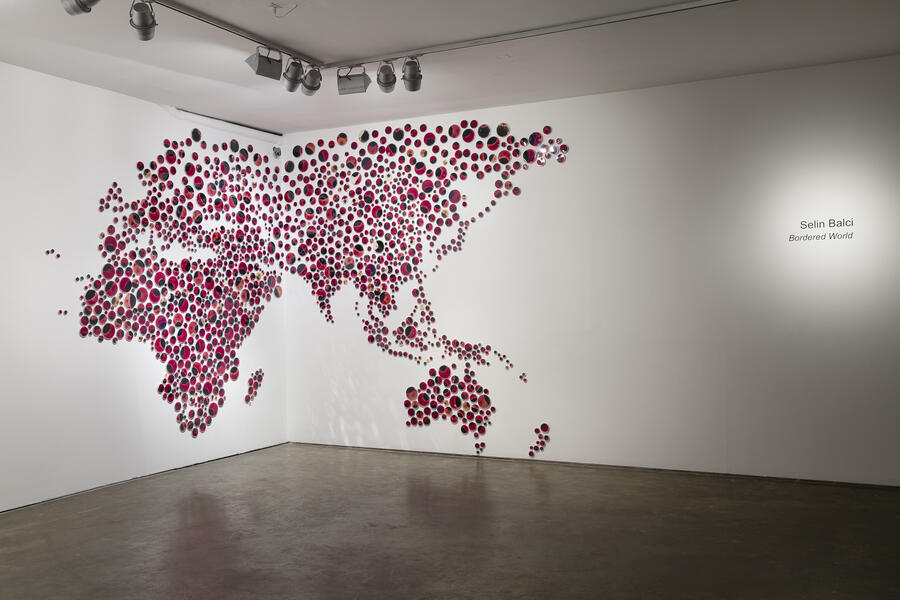 Bordered WorldEvolving mold in 2500 Petri dishes at Smack Mellon, Brooklyn, NY, 2014-15
Bordered WorldEvolving mold in 2500 Petri dishes at Smack Mellon, Brooklyn, NY, 2014-15 -
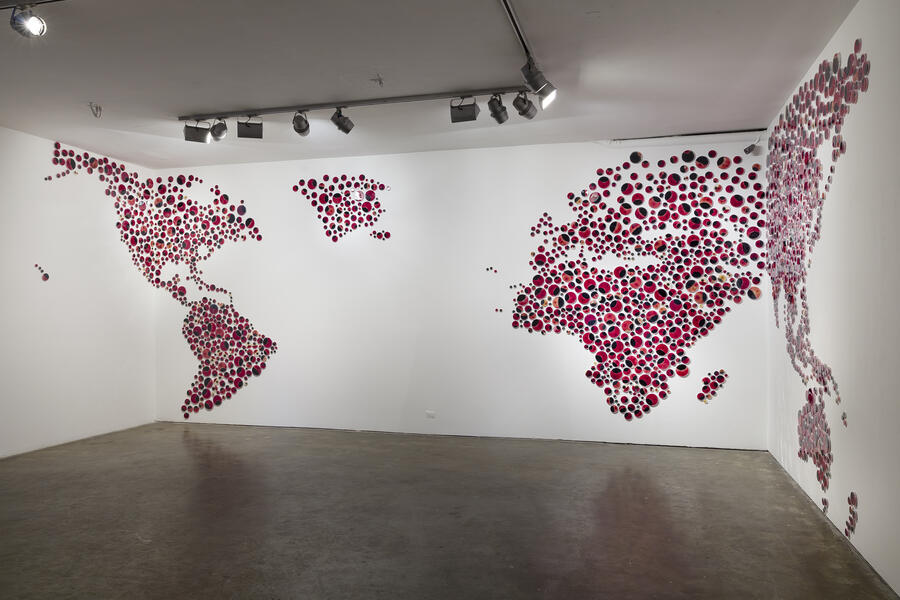 Bordered WorldEvolving mold in 2500 Petri dishes at Smack Mellon, Brooklyn, NY, 2014-15
Bordered WorldEvolving mold in 2500 Petri dishes at Smack Mellon, Brooklyn, NY, 2014-15 -
Installation of Bordered World at Smack Mellon galleryEvolving mold in 2500 Petri dishes at Smack Mellon, Brooklyn, NY, 2014-15
Contamination Series, 2013-2018
-
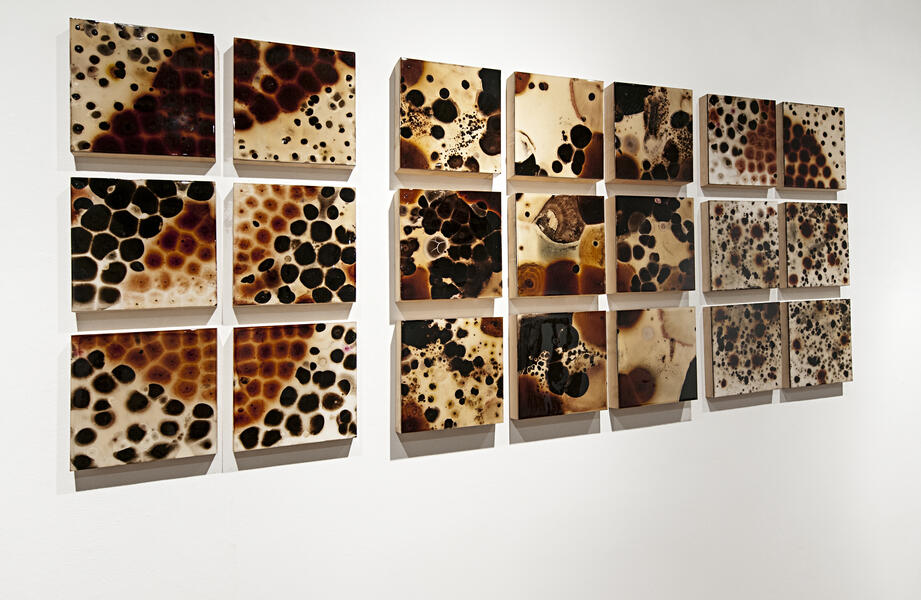 Annapolis (Highland Beach)Microscopic mold on panels, 40x100”, 2018 at School 33 Gallery, Baltimore, Maryland. In this work, I used microscopic mold that is collected from Highland Beach, Annapolis to create an unseen landscape of the scene. Emerging from a diverse array of mold, this work interprets the landscape with invisible inhabitants.
Annapolis (Highland Beach)Microscopic mold on panels, 40x100”, 2018 at School 33 Gallery, Baltimore, Maryland. In this work, I used microscopic mold that is collected from Highland Beach, Annapolis to create an unseen landscape of the scene. Emerging from a diverse array of mold, this work interprets the landscape with invisible inhabitants. -
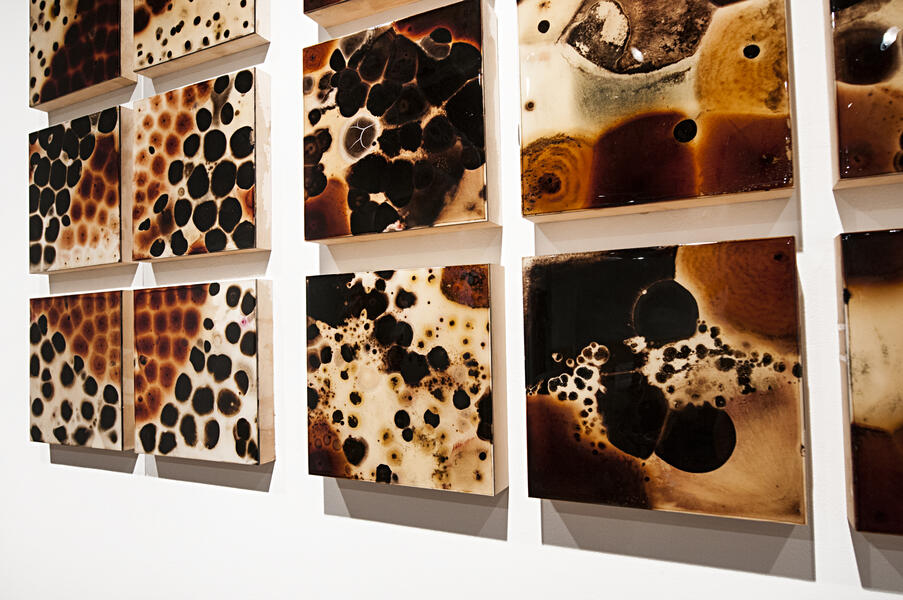 Annapolis (Highland Beach)Microscopic mold on panels, 40x100”, 2018
Annapolis (Highland Beach)Microscopic mold on panels, 40x100”, 2018 -
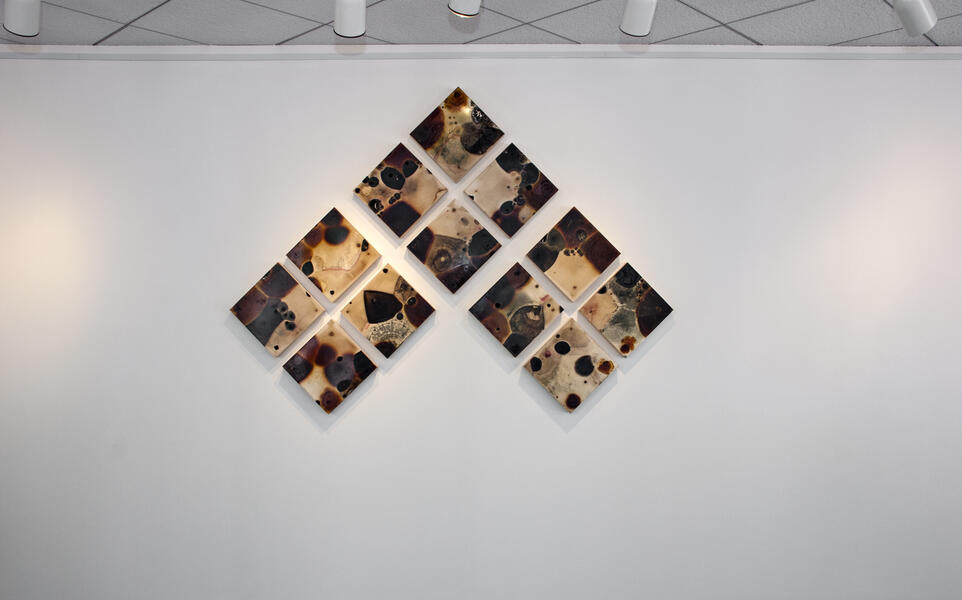 Contamination 28Contamination'28', mold on panels, 60x60", 2014 at Trawick Prize Exhibition, Gallery B, Bethesda, Maryland. DESCRIPTION: I use live microscopic mold that leaves physical inscriptions by direct contact on the surface of a paper or board, which creates a living platform. In Contamination Series, the surface of each panel is laced with graceful, brilliant mold until the entire surface is covered and patterned with circular borders. Then, I assembled these forms and shapes that mold produced, to create various visual references that can relate to both natural and human impacted landscapes. The forms have similarities to human-induced activities on the landscape. They create territories, boundaries, and borderlines and end up with conflicts on the picture surface. "Balci gives living microbes a place to grow and organize themselves on specially prepared plates. The microorganisms, which normally are invisible to the naked eye, are made visible in these conditions. They create maps of “territories” as they battle for the food sources, and their behavior is disturbingly parallel to many scenarios of human conflict. The artist organizes and assembles the landscapes or maps that result from these natural migrations into abstract compositions that are limited in tonal variation but elegant in form." by Claudia Rousseau, Gazette.net, September 18, 2013.
Contamination 28Contamination'28', mold on panels, 60x60", 2014 at Trawick Prize Exhibition, Gallery B, Bethesda, Maryland. DESCRIPTION: I use live microscopic mold that leaves physical inscriptions by direct contact on the surface of a paper or board, which creates a living platform. In Contamination Series, the surface of each panel is laced with graceful, brilliant mold until the entire surface is covered and patterned with circular borders. Then, I assembled these forms and shapes that mold produced, to create various visual references that can relate to both natural and human impacted landscapes. The forms have similarities to human-induced activities on the landscape. They create territories, boundaries, and borderlines and end up with conflicts on the picture surface. "Balci gives living microbes a place to grow and organize themselves on specially prepared plates. The microorganisms, which normally are invisible to the naked eye, are made visible in these conditions. They create maps of “territories” as they battle for the food sources, and their behavior is disturbingly parallel to many scenarios of human conflict. The artist organizes and assembles the landscapes or maps that result from these natural migrations into abstract compositions that are limited in tonal variation but elegant in form." by Claudia Rousseau, Gazette.net, September 18, 2013. -
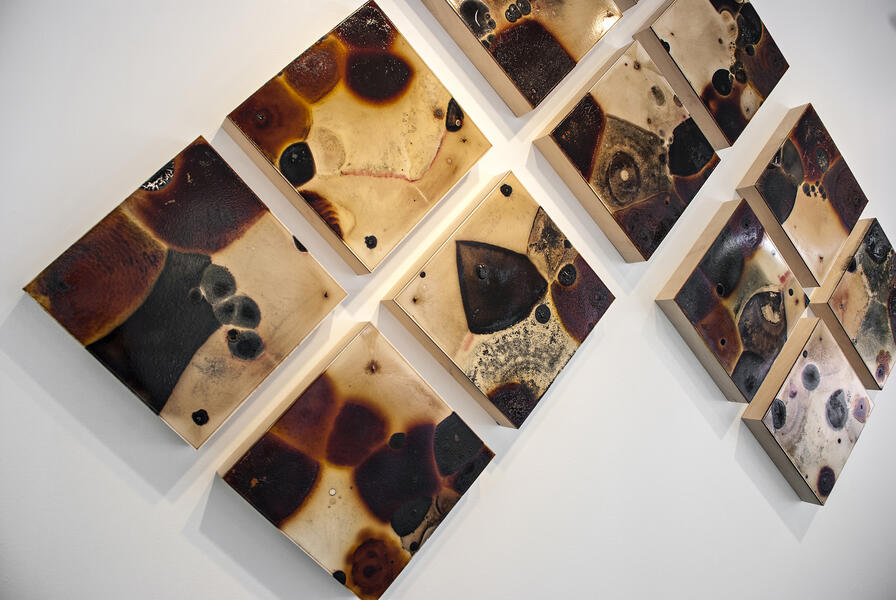 Contamination 28 (detail)Contamination'28', mold on panels, 60x60", 2014 at Trawick Prize Exhibition, Gallery B, Bethesda, Maryland.
Contamination 28 (detail)Contamination'28', mold on panels, 60x60", 2014 at Trawick Prize Exhibition, Gallery B, Bethesda, Maryland. -
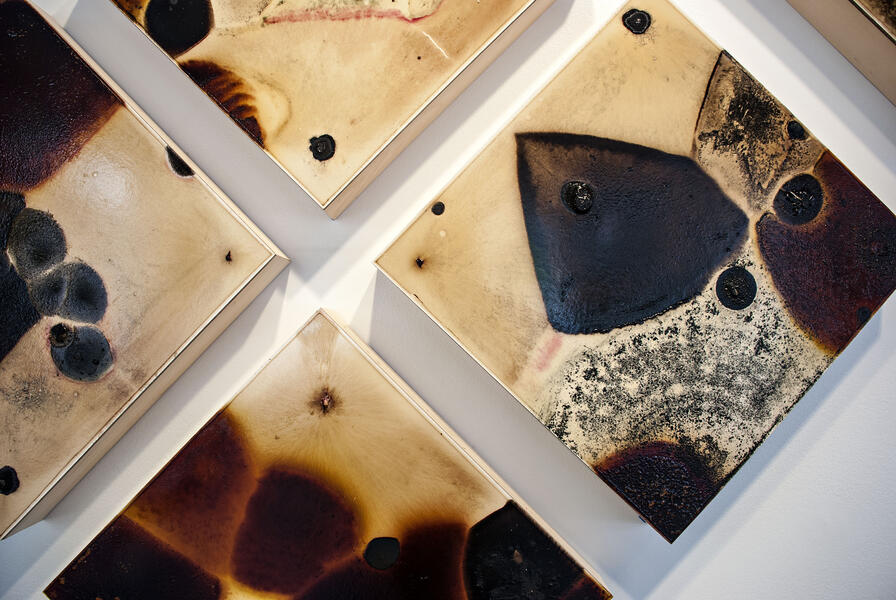 Contamination 28 (detail)Contamination'28', mold on panels, 60x60", 2014 at Trawick Prize Exhibition, Gallery B, Bethesda, Maryland.
Contamination 28 (detail)Contamination'28', mold on panels, 60x60", 2014 at Trawick Prize Exhibition, Gallery B, Bethesda, Maryland. -
 Contamination 32Contamination 32, mold on panels, 70x70", 2013 The University of Maryland, College Park Stamp Student Union, Contemporary Art Permanent Collection, College Park, MD.
Contamination 32Contamination 32, mold on panels, 70x70", 2013 The University of Maryland, College Park Stamp Student Union, Contemporary Art Permanent Collection, College Park, MD. -
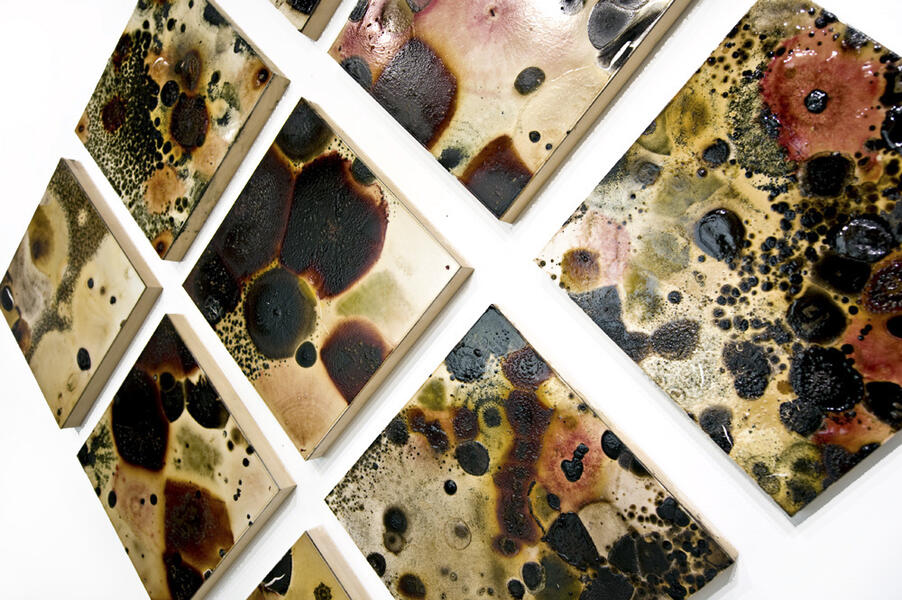 Contamination 32Contamination 32, mold on panels, 70x70", 2013 The University of Maryland, College Park Stamp Student Union, Contemporary Art Permanent Collection, College Park, MD.
Contamination 32Contamination 32, mold on panels, 70x70", 2013 The University of Maryland, College Park Stamp Student Union, Contemporary Art Permanent Collection, College Park, MD. -
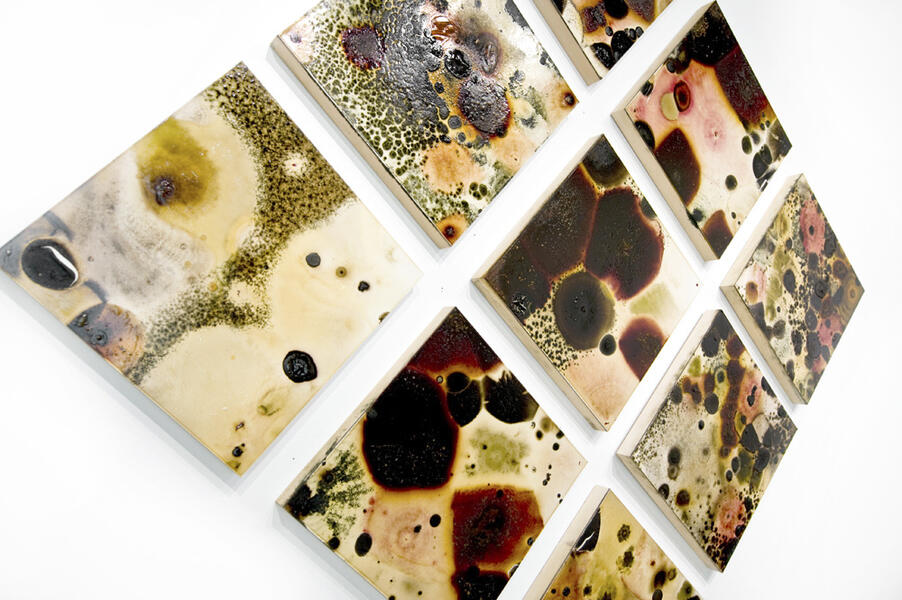 Contamination 32Contamination 32, mold on panels, 70x70", 2013 The University of Maryland, College Park Stamp Student Union, Contemporary Art Permanent Collection, College Park, MD.
Contamination 32Contamination 32, mold on panels, 70x70", 2013 The University of Maryland, College Park Stamp Student Union, Contemporary Art Permanent Collection, College Park, MD. -
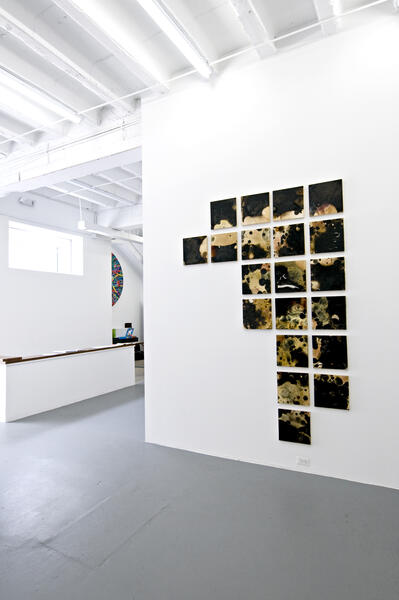 Contamination IIContamination II (detail), mold on panels, 60x110", 2012 at ConnerSmith Gallery, Washignton, DC
Contamination IIContamination II (detail), mold on panels, 60x110", 2012 at ConnerSmith Gallery, Washignton, DC -
 Contamination II (detail)Contamination II (detail), mold on panels, 60x110", 2012 at ConnerSmith Gallery, Washignton, DC
Contamination II (detail)Contamination II (detail), mold on panels, 60x110", 2012 at ConnerSmith Gallery, Washignton, DC
The World
"If the artistic process is more interesting than the outcome, as some modernists hold, then the greatest artist is nature itself. Its systems are endless and inexorable, even if the results aren’t always impressive to the naked eye. Take, for example, the fungal experiments of Selin Balci, one of five former Hamiltonian Artists fellows who return to the gallery in “Empirical Evidence.” The Turkey-born Marylander is exhibiting such seemingly inert items as petri dishes that contain slowly evolving mold spores. Far more dramatic is a more artist-directed piece, a five-minute fast-motion video in which molds spread across a world map. It demonstrates the power and scope of the tiniest living things."
Mark Jenkins, October 1, 2021, The Washington Post
"The map-based works present this phenomenon in stark terms, played out as geopolitical headlines ripped from the paper. The World depicts worlds run amok by war, disease or possibly famine. Faint pencil outlines suggest physical boundaries that the organisms push to the brink. Teaming and frothing, they have no “place” to go, and so they turn on one another in a game of brinkmanship, drawing boundaries with battlegrounds to gain the upper hand. The pieces are both eerie and transfixing, haunting yet mesmerizing, and their underlying message could be ignored offhand, if not because we see similar battles taking place today in regions as remote as Syria and as near as Dallas." Eric Hope for East City Art, 2014.
-
 The WorldThe World (4th version), 2020, Mold spores on panel covered with epoxy resin, 24x40" I used mold to specifically refer to human behavior, culture and society. The world's political map was re-created on a board with growth media (food), then different microorganisms were placed to represent each country. The work demonstrates human actions, form of power, political pressures, immigration, racialism and the dominance of superior countries.
The WorldThe World (4th version), 2020, Mold spores on panel covered with epoxy resin, 24x40" I used mold to specifically refer to human behavior, culture and society. The world's political map was re-created on a board with growth media (food), then different microorganisms were placed to represent each country. The work demonstrates human actions, form of power, political pressures, immigration, racialism and the dominance of superior countries. -
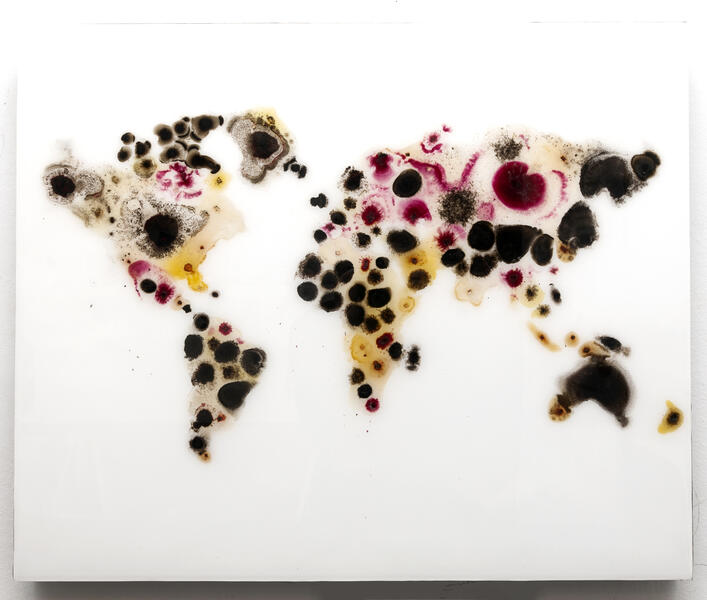 The World (5th version)The World (5th version), 2020, Mold spores on panel covered with epoxy resin, 16x20"
The World (5th version)The World (5th version), 2020, Mold spores on panel covered with epoxy resin, 16x20" -
The WorldThe World, video, originally 4:33min, 2010 I used mold to specifically refer to human behavior, culture, and society. The world's political map was re-created on a board with growth media (food), then different microorganisms were placed to represent each country. The work demonstrates human actions, forms of power, political pressures, immigration, racialism, and the dominance of superior countries.
-
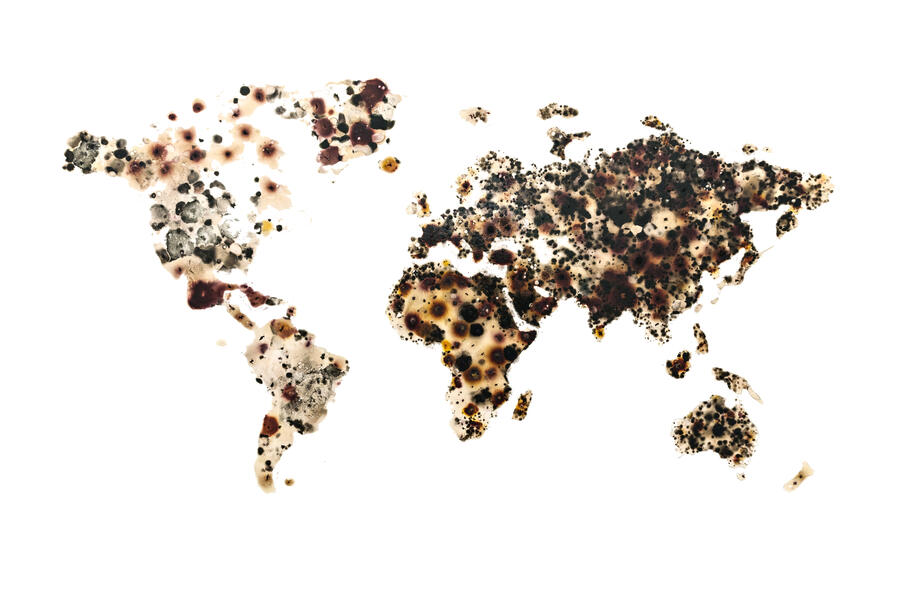 The World (1st version)Mold spores on panel, 2012, 24x40"
The World (1st version)Mold spores on panel, 2012, 24x40"
200
-
200200, speciments and evolving mold in Petri dishes, 2015 at Zorlu Center, Istanbul, Turkey
-
200200, speciments and evolving mold in Petri dishes, 2015 at Zorlu Center, Istanbul, Turkey
-
200200, speciments and evolving mold in Petri dishes, 2015 at Zorlu Center, Istanbul, Turkey
-
200200, speciments and evolving mold in Petri dishes, 2015 at Zorlu Center, Istanbul, Turkey
-
200200, speciments and evolving mold in Petri dishes, 2015 at Zorlu Center, Istanbul, Turkey
-
200200, speciments and evolving mold in Petri dishes, 2015 at Zorlu Center, Istanbul, Turkey
-
200200, speciments and evolving mold in Petri dishes, 2015 at Zorlu Center, Istanbul, Turkey
-
200200, speciments and evolving mold in Petri dishes, 2015 at Zorlu Center, Istanbul, Turkey
-
200200, speciments and evolving mold in Petri dishes, 2015 at Zorlu Center, Istanbul, Turkey
Land
"Selin Balci also considers space exploration, though it's from a more removed perspective. Balci’s piece is a magnified image of a series of petri dishes, with each simultaneously functioning as zoomed-in representations of cells. It's large and spreads across most of the wall—most visible, like a microscope, from far away. When you take three or four steps back, ‘Land’ forms a constellation of sorts in which the dishes are gathered in clusters that meander in a downward slope. In the past, Balci has organized them into the worldmap, and in ‘Land’ she uses these petri dishes, which quarantine the smallest of humanly known substances and each act like their own star, to emblematize outer space phenomena—the most humanly inconceivable shit ever, really. The piece is a convergence of the most extreme forms of zooming-in and zooming-out. For Balci, microscopes might as well be telescopes."
By Eli Zeger, City Paper
-
 LandLand, Mold on yupo paper covered with watch glasses, 2016
LandLand, Mold on yupo paper covered with watch glasses, 2016 -
 LandLand, Mold on yupo paper covered with watch glasses, 2016
LandLand, Mold on yupo paper covered with watch glasses, 2016 -
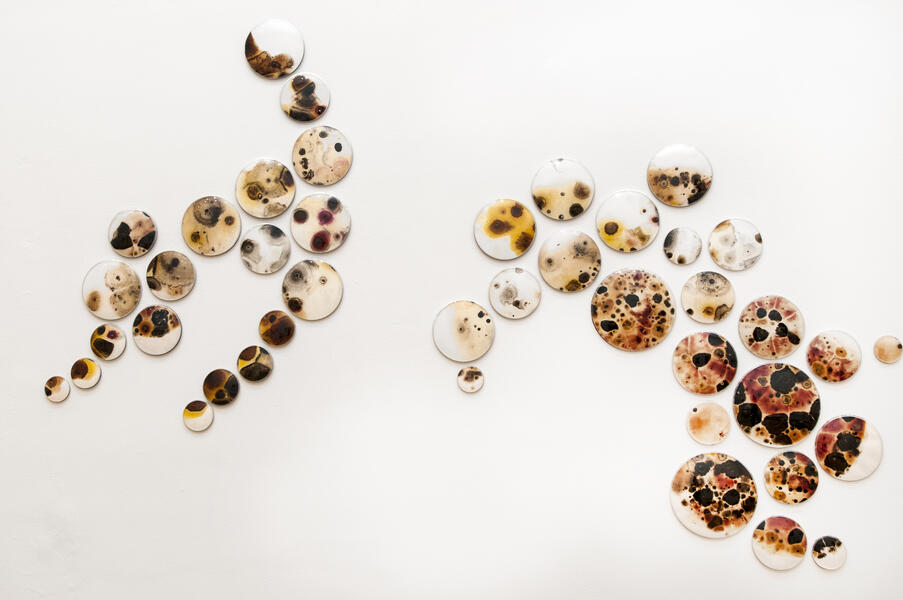 LandLand, Mold on yupo paper covered with watch glasses, 2016
LandLand, Mold on yupo paper covered with watch glasses, 2016 -
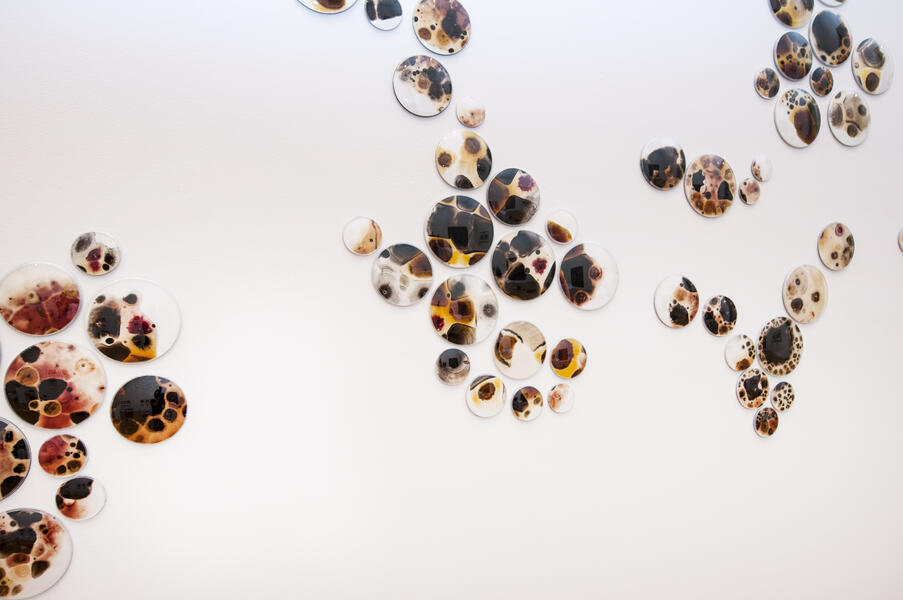 LandLand, Mold on yupo paper covered with watch glasses, 2016
LandLand, Mold on yupo paper covered with watch glasses, 2016 -
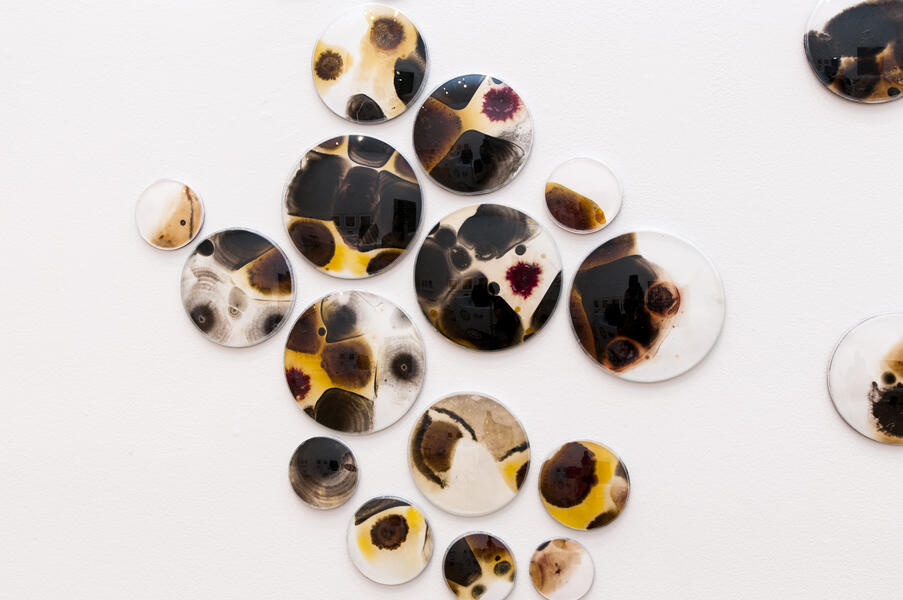 LandLand, Mold on yupo paper covered with watch glasses, 2016
LandLand, Mold on yupo paper covered with watch glasses, 2016 -
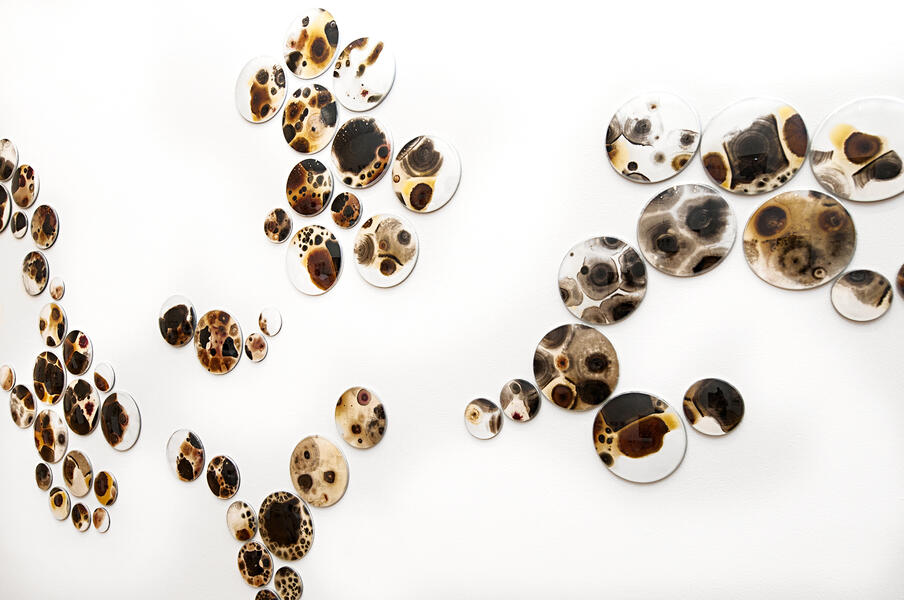 LandLand, Mold on yupo paper covered with watch glasses, 2016
LandLand, Mold on yupo paper covered with watch glasses, 2016 -
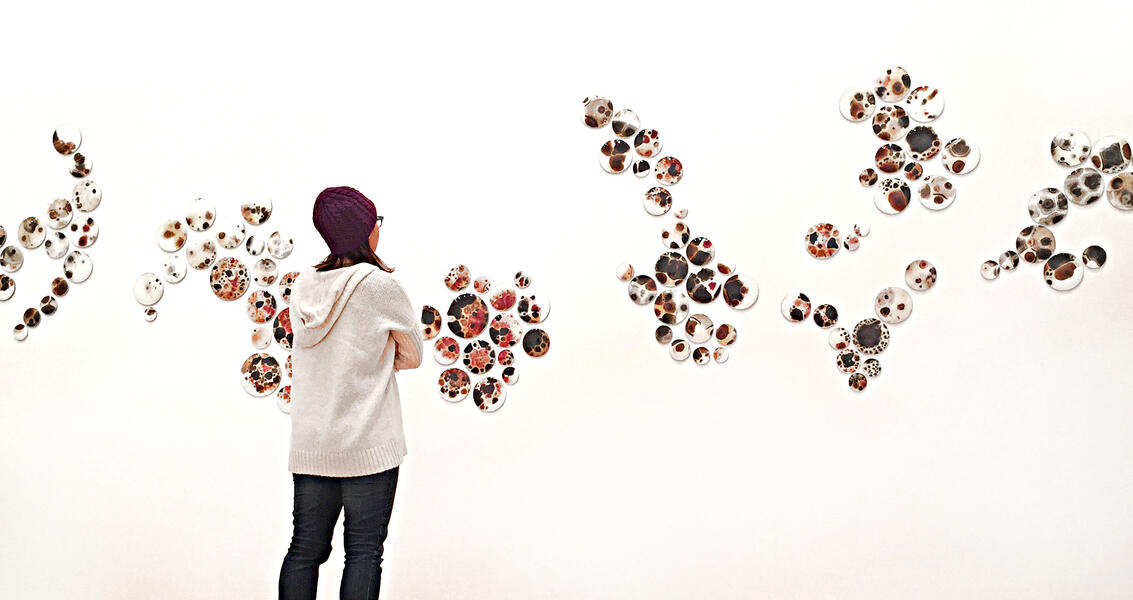 LandLand, Mold on yupo paper covered with watch glasses, 2016
LandLand, Mold on yupo paper covered with watch glasses, 2016
